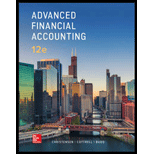
Concept explainers
a.
Concept Introduction:
Consolidation: Merger is a combination where two entities merge to take the benefit of synergies where and assets and liabilities of the two entities combine to form a new entity.
the number of shares did P issue to acquire Stork’s assets and liabilities.
a.
Answer to Problem 1.38P
The number of shares issued is
Explanation of Solution
Computation of a number of shares issued:
b.
Concept Introduction:
Consolidation: Merger is a combination where two entities merge to take the benefit of synergies where and assets and liabilities of the two entities combine to form a new entity.
the total market value of the shares issued by P.
b.
Answer to Problem 1.38P
The total market value of the shares issued by P is
Explanation of Solution
Computation of the total market value of the shares issued:
c.
Concept Introduction:
Consolidation: Merger is a combination where two entities merge to take the benefit of synergies where and assets and liabilities of the two entities combine to form a new entity.
the fair value of inventory held by S at the date of combination.
c.
Answer to Problem 1.38P
The fair value of inventory held by Stork at the date of combination is
Explanation of Solution
Computation of fair value of inventory held:
d.
Concept Introduction:
Consolidation: Merger is a combination where two entities merge to take the benefit of synergies where and assets and liabilities of the two entities combine to form a new entity.
the fair value of identifiable net assets held by Stork at the date of combination.
d.
Answer to Problem 1.38P
The fair value of identifiable net assets held by Stork at the date of combination is
Explanation of Solution
Computation of the fair value of identifiable net assets held:
| Particulars | Amount | |
| Cash | ||
| Accounts Receivable | ||
| Inventory | ||
| Building and Equipment (Net) | ||
| Accounts Payable | ||
| Bonds Payable | ||
| Bonds Premium | ||
| Net Assets of Combined Entity | ||
| Cash | ||
| Accounts Receivable | ||
| Inventory | ||
| Building and Equipment (Net) | ||
| Accounts Payable | ||
| Bonds Payable | ||
| Bonds Premium | ||
| Net Assets of P Inc. | ||
| Net Assets of S Company |
e.
Concept Introduction:
Consolidation: Merger is a combination where two entities merge to take the benefit of synergies where and assets and liabilities of the two entities to combine to form a new entity.
the amount of
e.
Answer to Problem 1.38P
The amount of goodwill is
Explanation of Solution
Computation of fair value of identifiable net assets held:
Total Market Value of shares of P Inc. LessNet Assets of S Company
f.
Concept Introduction:
Consolidation: Merger is a combination where two entities merge to take the benefit of synergies where and assets and liabilities of the two entities to combine to form a new entity.
the balance in
f.
Answer to Problem 1.38P
The balance in retained earnings to be reported is
Explanation of Solution
The number is reported in its financial statement by P Inc. of
g.
Concept Introduction:
Consolidation: Merger is a combination where two entities merge to take the benefit of synergies where and assets and liabilities of the two entities combine to form a new entity.
the amount of
g.
Answer to Problem 1.38P
The balance in retained earnings to be reported is
Explanation of Solution
Computation of depreciation amount:
Want to see more full solutions like this?
Chapter 1 Solutions
Advanced Financial Accounting
- I am trying to find the accurate solution to this general accounting problem with appropriate explanations.arrow_forwardWhat is the primary goal of financial management?A) Maximizing profitsB) Maximizing shareholder wealthC) Minimizing costsD) Ensuring liquidityarrow_forwardWhich of the following is NOT an example of an operating activity in cash flow statement? a) Receipts from customersb) Payments to suppliersc) Proceeds from issuing sharesd) Payments to employeesarrow_forward
- Can you solve this general accounting problem using accurate calculation methods?arrow_forwardPlease provide the answer to this general accounting question using the right approach.arrow_forwardThe accounting equation is:a) Assets + Liabilities = Equityb) Assets = Liabilities + Equityc) Liabilities = Assets + Equityd) Assets + Equity = Liabilitiesarrow_forward
- General Accountingarrow_forwardThe primary objective of financial accounting is to:a) Provide management with detailed reports for decision-making.b) Help the company save taxes.c) Provide financial information to external users.d) Track inventory levels. need help!arrow_forwardI need help with this general accounting problem using proper accounting guidelines.arrow_forward
